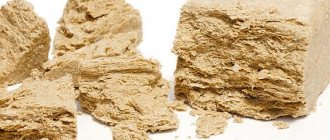Kefir - a tradition of fermented milk complementary foods
The love for fermented milk drink in Russia began in 1922. It was then that the first dairy kitchen was opened at the Institute of Maternal and Child Health. Pediatricians, speaking about the proper development of a child, prioritized the topic of a balanced diet and tirelessly recommended introducing kefir into the baby’s diet. Doctors still adhere to this same line, knowing about the miraculous properties of the product. And mothers themselves have long known that kefir is a storehouse of vitamins and microelements.
It is a proven fact that the daily intake of kefir provides 30% of the daily intake of calcium and protein. According to doctors' calculations, a 200-ml packet contains 5.4 grams of protein and 240 milligrams of calcium - the daily requirement of a one-year-old child.
Kefir vs kefir – differences or how to choose a healthy drink?
You should not naively believe that any fermented milk product from the store shelf will be useful for your baby, because kefir and kefir are different. Most modern parents believe that the more expensive the product, the more colorful the packaging and the richer the composition, the better - it will bring maximum benefit. This opinion is often deceptive and quickly breaks down against the walls that professional marketers of large corporations build.
"Suitable for baby food"
When choosing a quality drink for a child, the priority is not packaging, but an adapted recipe, strict quality control and safety. Look for the age statement on the packaging to ensure that it is indeed a certified baby food product. Only children's kefir can boast of this.
Small, not big
Many will say “there is no difference between kefir for a baby and kefir for an adult.” This is wrong. More stringent requirements are imposed on the production of kefir for babies. For example, security requirements. Children's kefir is produced only on separate lines and in a closed mode, and the sterility of the premises and technological devices is sometimes envied even by the walls of a hospital operating room.
Low acidity
When talking about the difference in children's and adult kefir, it is very important to mention acidity. The recipe for the drink for babies is adapted to the characteristics of a fragile body. The acidity in the children's drink is limited to no more than 100 Turner degrees, which allows it to be absorbed faster.
REMEMBER: Acidity may increase during storage, so it is very important to look at the expiration date and choose the freshest possible product for your child.
For comparison, in adult kefir there are no restrictions on acidity, which can play a cruel joke on a child and cause discomfort.
Basic rules for drinking fermented milk drink by a child
Kefir is an extremely healthy and nutritious product. But if you violate the rules for its use or storage, it can cause serious harm to the child’s health.
Attention
During an illness that is accompanied by an increase in body temperature, it is strictly forbidden to offer the child any fermented milk products and milk porridges. This is due to the fact that casein has the property of “coagulating” at elevated temperatures, and therefore is difficult to break down. Instead of fighting the disease, the body has to spend a lot of energy digesting practically “rubbery” food, which as a result provokes the accumulation of acetone.
Rules for storing and using baby kefir:
Kefir intended for a child must be fresh. If you are buying a ready-made product for a child, then you should choose freshly produced kefir with the shortest shelf life. The longer kefir can “live”, the more preservatives it contains.- The drink must be stored under the right conditions: at a temperature of zero to six degrees. Once the package is opened, kefir cannot be stored even in the refrigerator.
- Packaging integrity. There should be no damage, dents or other defects on the packaging of baby kefir.
- A child can only be offered kefir at room temperature, so before consuming it, it should be taken out of the refrigerator an hour or an hour and a half before meals. It is not recommended to use heating household appliances. If you need kefir in the near future, you can warm it up a little in a water bath.
- It is better to offer your child kefir separately from other foods.
- If the baby flatly refuses a fermented milk drink, then the parents have two options:
- postpone your introduction to kefir for some time;
- add fruits already familiar to the baby (in the form of puree) or baby cookies to the drink.
Important
It is worth knowing that fruit juices can neutralize lactobacilli, the presence of which affects the usefulness of kefir.
Many parents resort to sweetening kefir with sugar, which is strictly not recommended. Firstly, sugar itself will not bring anything beneficial to the child’s body other than health problems, and secondly, sweetened kefir causes severe gas formation in children, accompanied by pain.
Let us add that a reasonable approach of parents to kefir complementary feeding allows not only to painlessly diversify the child’s diet, but also to significantly improve the overall well-being and digestion of the baby. Before introducing a fermented milk product into the children's menu, be sure to consult your pediatrician.
Tokareva Larisa, pediatrician, medical columnist
18 total today
( 176 votes, average: 4.56 out of 5)
When and how to potty train a child
Co-sleeping with a child: pros and cons, safety issues
Related Posts
Packaging features and composition pitfalls
Let's talk about marketing and other tricks. Despite all the strictness of production and quality control, read the information on the packaging of the product you like.
Firstly, the composition. For high-quality kefir, it is quite simple and understandable: only milk and kefir grains. In addition, the drink should not contain sugar. This makes it doubly safe for first feeding. Artificial colors, flavor enhancers, GMOs and preservatives are prohibited in children's kefir. Every conscientious manufacturer adheres to this rule.
Does your baby’s favorite kefir still contain additional ingredients besides vitamins and bifidobacteria? It's not kefir in your hands! Additives change the beneficial properties of the drink and turn it into an ordinary delicious dessert. For example, in “Kefirny”, “Kefirchik” or “Kefirok”. On a package of this healthy drink you can easily find the inscription “Kefir. Baby food".
"Agusha": preserving traditions for the little ones
Classic kefir “Agusha” is a favorite product of mothers and babies. Mom can be confident in the safety of the product: strict control at every stage of production guarantees quality. In addition, low acidity and the absence of sugar make this kefir suitable for introducing complementary foods. And kids love “Agusha” for its incredibly delicate taste!
We also read:
Do you want to be the first to read our materials? Subscribe to our telegram channel, Facebook page, or VKontakte group.
We are at Yandex.Zen - join us!
Educational games for children from 2 to 10 years old:
Advertising, advertising, advertising(((I once bought a bag of Agusha kefir (which you advertise) so that I could try it before introducing it to a child. Sour and nasty kefir, even an adult will taste softer than this “childish”, unfinished bag went to the trash bin. I will look for another kefir
Video guide: breastfeeding
When your baby is six months old, it is time to diversify his diet and introduce complementary foods. This is necessary for both the mother and the newborn. His still tiny organism develops, grows and requires more and more diverse nutrients. The first month or two should be devoted to baby cereals and fruit and vegetable purees. But from 7-8 months it’s time for fermented milk products. The baby’s digestive system is not yet fully activated, but she can already cope with kefir and baby cottage cheese, especially since these same products will help her.
Differences between adult and children's kefir
A children's drink differs from an adult drink in having less acidity and fat content.
Classic kefir can cause vomiting or indigestion in a child. The baby’s body is not yet able to cope with sour foods, so the baby drink is made to have a milder taste. In addition, a child under 3 years of age has not yet developed enzymes that help digest high-fat foods. For the production of children's kefir, only the highest grade milk is used, while the first grade is suitable for adult products.
Nutritionists recommend introducing the classic drink into a child’s diet only from the 3rd year of life.
The benefits of fermented milk products for babies
Surely any mother knows this, but it wouldn’t hurt to repeat it. So:
- Kefir is a source of calcium, necessary for the growth and formation of bones and teeth.
- The bacteria contained in the drink actively participate in the normalization and stimulation of the digestive system.
- good for muscles, cartilage and other soft tissues.
- strengthens the immune system.
- increases appetite.
Of course, it does not affect all vital organs and systems, but the benefits are quite obvious.
How to introduce kefir into complementary feeding for infants
Babies who receive plenty of mother's milk do not need to rush into this. First, you should introduce the toddler's stomach to fruit and vegetable purees. They are easier to digest and prepare the digestive system for the following foods. The optimal option is considered to be 7-8 months of age, and some simple rules will help the baby accept a new type of diet without any unpleasant consequences.
- The very first portion should not exceed 2-3 teaspoons, after which supplementary feeding should be done either with breast milk or, if the baby is bottle-fed, with a special infant formula.
- You should wait at least 2 days before the second time. This is done due to the fact that an allergy to kefir in a baby may not appear immediately, and you can only aggravate it with impatience. Such a break is necessary for the baby’s body to better get used to the drink itself.
- Since kefir tends to increase appetite, it is better to give it in the first half of the day.
- Adding sugar is strictly prohibited. This combination will cause fermentation in the baby’s stomach, which will lead to not very pleasant consequences in the form of colic and gas. If the baby does not like the sour taste of kefir, there is always the opportunity to sweeten it a little with a small amount of fruit puree.
- If no negative reactions occur, you can safely increase the portion to 4-5 teaspoons.
What to choose: store-bought kefir or homemade?
Store-bought kefir or homemade?
Retail chains offer so many specialized children's products that an inexperienced mother's eyes run wild. Reading the label and ingredients of each means wasting time that could be devoted to other more important activities, but this does not mean that you can grab the first product you see off the shelf. Moreover, the ubiquitous Internet, and television, every now and then throw up stories dedicated to the unsatisfactory quality of all kinds of products, which make the hair stand on end. You don’t have to believe everything, but caution doesn’t hurt. If you decide to buy kefir in a store, be sure to pay attention to some aspects.
- “Children’s” should be written on the packaging in large letters. This is not a publicity stunt. This is a mandatory indication that the product has undergone special adaptation.
- The shelf life should be minimal. If this is not the case, then kefir contains preservatives.
- Be sure to check the integrity of the packaging.
- If your baby reacts negatively to kefir from one manufacturer, this does not mean that you should completely abandon the purchased product. In this case, you should try a different brand of kefir.
- You should not buy baby kefir for future use. It's better to go to the store one more time.
These rules can protect your baby from a low-quality product, but only self-prepared kefir can provide complete safety. Here you will know exactly what, how and by what technology the product is prepared, and if everything is done correctly and with soul, no problems should arise.
What kind of kefir can be given to a child?
There are many brands of children's kefir on the market today. These are “Agusha” and “Our Masha”. Recently, kefir “Fruto-Nanny” has appeared. The difference between them is the price.
Children's kefir, unlike adult kefir, has less fat content. The milk and starter in its composition are of the best quality. All products for children undergo strict quality control. Children's kefir should not contain starch, preservatives, or additives.
You need to start giving kefir at 30 ml per day. Be sure to pay attention to the child's reaction.
Adult kefir can be given to a child over 3 years old.
How to make kefir for babies at home
How to make kefir
The question of how to make kefir for babies at home is asked by almost all young mothers. The same manufacturers, in order to advertise their products, claim that this is a complex and responsible process, accessible only in the super-sterile conditions of their production. In fact, everything is much simpler and more accessible. To do this, you will need a certain amount of cow's milk (goat milk gives a somewhat unusual taste), a starter, which can be ordinary sour cream, a clean saucepan and a sterilized jar with a tight lid. And, of course, quite a bit of free time. So let's get started:
- A liter of milk should be boiled for 6-7 minutes. It’s not an easy task, I must say, because holding boiling milk in a saucepan is a real art, but over time you will get so good at it that you will do it without looking at the stove.
- Wait until the milk cools down. Do not put it in the refrigerator or take it out onto the balcony. With sudden cooling, it will lose most of its beneficial and nutritional qualities.
- Pour the milk into a prepared sterilized glass jar.
- After the milk has cooled, you can safely add the starter, a teaspoon of sour cream per glass and leave to sour for 10 hours. Better in a warm and dark place. The amount of sour cream can be adjusted if you subsequently feel that the consistency of kefir does not meet your wishes.
- You take out the jar, open it and, having first tried what happened, and it should turn out perfectly, give it to your baby.
Instead of sour cream, you can use the same children's purchased kefir, of proven quality, you just need to decide on the amount that you will add to the prepared milk. You can also buy special starter cultures sold in pharmacies. For example, Narine sourdough. The principle of preparation will change little, but it will allow you not to run to the store every time for sour cream or baby kefir.
Which kefir to choose for feeding a newborn, purchased or homemade, is an individual choice. One thing can be said for sure: kefir is a very healthy and necessary product that has a very beneficial effect on a variety of functions of a small organism. Well, it has only one contraindication – individual intolerance to milk protein, which is very rare.
The benefits of kefir for children
Fermented milk products contain many useful substances, but it is kefir that helps increase the secretion of enzymes, helping the digestive system work better and normalize intestinal microflora . A growing body requires a large amount of vitamins, proteins and minerals for good growth and formation of organs and various systems.
The value of kefir in complementary feeding lies primarily in the fact that it:
- is absorbed well in most cases;
- helps stimulate appetite;
- has a good effect on metabolic processes;
- contains a number of vitamins, especially group B;
- inhibits the growth of those pathogenic bacteria that are found in the gastrointestinal system.
In addition, this drink is low-calorie : per 100 grams there is only 1.5 percent. fat, and the consistency is very close to breast milk.
Each child has individual dietary characteristics, therefore, when introducing kefir as complementary foods, parents should consult with a pediatrician and strictly monitor the child’s condition after the first spoons of this fermented milk drink.
Consumer product characteristics
Any product or product has its own characteristics. And they are the main criteria for choosing a product.
Fat content of kefir
As a rule, fat content is 3.2%, 2.5, 1, and zero. with a declared zero fat content there may be 0.01% fat, this is indicated on the packaging, often in small numbers. If you have gastrointestinal diseases or other chronic ailments, you should take into account the recommendations of specialists, nutritionists or your doctor as to which drink with what level of fat content is most suitable for a person.
Package
Any packaging must have a sealing function. Popular companies sell kefir in various packaging: cardboard tetra-packs and tetra-fino, plastic bags, plastic bottles and others. Cardboard packaging is more natural and is considered an environmentally friendly option
Kefir is produced in plastic bottles, they are convenient to store, but food industry experts talk about the dangers of plastic.
Consistency and taste
Taste is a purely individual criterion; some people lack sourness in the chosen drink, while others, on the contrary, consider the product too sour. Therefore, you can choose your own kefir to taste only by trial and error.
Consistency also plays an important role; if it is uneven, some people do not perceive such a product. And children especially do not like kefir with lumps.
Content
Even if it is ordinary kefir, it may contain starch and other harmful substances. And the natural product contains beneficial bacteria that have a beneficial effect on the human intestinal microflora. Therefore, it is important to carefully read the label, namely the information about the composition, in order to avoid purchasing a drink with existing ingredients that are not included in the original recipe.
Preparation method
Milk sours and turns into kefir thanks to fungi. Special starter cultures are added to the milk that is being prepared. The starting raw material, milk, can be different: reconstituted from powder, whole, skimmed.
Fungi can be added to milk before or after it is packaged. When fungi are added to the packaging, the milk sours right in it, creating a thick consistency. Such kefir will be called thermostatic kefir, and will have a more natural taste, as if prepared at home, using a starter. It does not grind, does not mix, and has an uneven consistency. The difference from a non-thermostatic product is that some beneficial bacteria are preserved to a greater extent. This method of preparation guarantees that the drink is natural. The manufacturer keeps it in containers in production for some time. Thermostatic kefir has a shorter shelf life and spoils faster.
Functionality and purpose of the drink, children's kefirs
We are accustomed to the fact that what is useful for children is also useful for adults. But this rule is not always relevant. Children have a different intestinal microflora. In order not to make a mistake when choosing, you need to consult a doctor or nutritionist, especially if the drink is purchased for the prevention or treatment of diseases. If the gastrointestinal tract system is disrupted or the child’s immunity is weakened, kefir will be very useful.
Children's kefir differs from that for adults, even in appearance. Such products are produced in glass bottles or cardboard bags. Plastic is contraindicated here. For baby kefir, milk is adjusted to the correct acidity. It is enriched with vitamins and microelements. Children's kefir is given until the age of three, and, as a rule, from 8 months. A baby who was not fed breast milk, but through artificial complementary feeding, can consume it from 7 months. There are products that can only be given to children aged three years and older. The taste of baby kefir is softer, has a sweetish tint, without a sour taste, and is more expensive.
Some well-known brands that have won a large number of fans make fermented milk products specifically for children. These are the companies Agusha, Fruto Nyanya, Danone, which produces products under the names Activia, Actimel, Rastishka and Prostokvashino. Also Zlagoda, Krepysh, products from the Baby Food Factory and others.
Shelf life
The normal shelf life of kefir is 2 weeks. The more natural the kefir, the shorter its shelf life. Ready-made kefir rarely has a shelf life of less than 5 days. Homemade kefir is stored for 3 days in the refrigerator, if stored in a bottle - only 36 hours. Open from the store - 24 hours.
Some buyers conduct experiments by keeping kefir longer than the expiration date in the refrigerator, for example, 9 days, when the expiration date is 4. Noticing that it has not spoiled, they doubt its naturalness, but allow it to be consumed. But manufacturers do not advise trying such a product, since it tastes and smells good, but it may contain a large number of harmful bacteria, and the experiment may have bad consequences.
How to introduce kefir into complementary foods for a child?
Many doctors are inclined to believe that kefir will be useful only after vegetable purees and fruits, cereals and meat have been introduced into the diet, explaining this by the fact that kefir is an unadapted product, and its composition does not really meet the needs of the baby.
Among children's doctors, disputes do not subside over when the child's body will accept new food without problems and complications.
Some believe that kefir can be given to babies as young as 6 months old, but most doctors insist, including WHO, that this complementary food should be introduced into the diet at a later date:
- if the child is breastfed after 8-9 months of age;
- if on artificial - after 7 months.
Kefir - first tests
What kind of kefir should I give my child and at what age should I start this kind of complementary feeding? The mentioned delicacy is not included in any complementary feeding scheme for modern children. It can be used as additional nutrition, but nothing more.
Pediatricians recommend postponing introducing your child to kefir. The product can be offered for the first time no earlier than 8 months. In addition, it is important to pay attention to the fact that “adult” kefir is generally prohibited for baby food. This is due to the fact that the child’s body simply cannot process such a product.
When is kefir harmful to a child?
It is not for nothing that doctors cautiously advise parents to introduce kefir into their diet. First of all, it contains casein . This is a complex protein with an amino acid composition, which makes kefir especially useful. But the baby’s intestinal enzymes are still too weak, they break down protein with difficulty, and casein has the ability to penetrate the intestinal walls and provoke an allergic reaction.
Kefir contains mineral salts and organic acids . Of course, they are useful, but they put a strain on the kidneys and digestive system.
How to give kefir to a child in complementary feeding, what portions are healthy
For some children, it is best to give kefir during the second morning feeding , while for others evening feeding with the inclusion of a fermented milk drink is most appropriate.
It must be administered very carefully, in small portions - 1-2 spoons. If the body reacts normally, the portion is gradually doubled. In this way, the dose is adjusted to 150–200 g, which is equivalent to one feeding portion.
When buying such a children's product, you need to check the integrity of the packaging and the date of sale.











